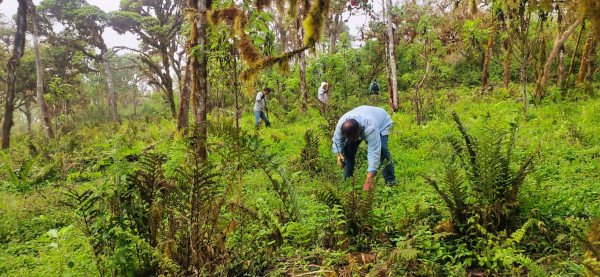12 Little Vermilion Flycatcher chicks fledge the nest, in most successful nesting season yet in Santa Cruz Island
The 12 new Little Vermilion Flycatchers are the result of 6 successful nests out of a total of 23 nesting attempts of a total of seven pairs.
The Charles Darwin Foundation’s (CDF) land bird conservation team is pleased to report that 12 new juvenile Little Vermilion Flycatchers successfully fledged following the 2023 nesting season. This is the most successful nesting season since the experimental management program of this species started in 2018. Previous nesting seasons recorded six fledglings in 2020, eight in 2021, and seven in 2022. The experimental management program is carried out by the Charles Darwin Foundation in collaboration with the Galapagos National Park Directorate (GNPD) and the University of Vienna.
The Little Vermilion Flycatcher (Pyrocephalus nanus) is endemic to the Galapagos Islands and is listed as “Vulnerable” by the International Union for Conservation of Nature (IUCN). On the islands of Floreana and Santa Fé, the species is locally extinct. On the island of Santa Cruz, where the program is implemented, there is a small population of approximately 30 individuals–or 15 pairs–that live in the Scalesia forest in the highlands.

Because of its small population size, conservation of the Little Vermilion Flycatcher on Santa Cruz Island is a top priority for CDF and GNPD scientists who are working on the experimental restoration of the island’s Scalesia forest, a key habitat for this little bird. The Scalesia restoration initiative seeks to reduce the impact of invasive species on this unique ecosystem, such as the blackberry (Rubus niveus), whose presence has completely changed the structure and functions of the local habitat, as well as the avian vampire fly (Philornis downsi), which parasitizes hatchlings, often causing all chicks in a nest to die or prompting nest abandonment.
Birgit Fessl, Principal Investigator of the CDF land bird conservation project comments: "These birds need a certain type of vegetation to find enough food and withstand the impact of the deadly avian vampire fly larvae. This requires enormous efforts from many people committed to the conservation of biodiversity in Galapagos. There are those who, day after day, dedicate themselves to uprooting newly sprouted blackberry and elderberry, and that keep invasive fern species to a minimum, and others who track birds to locate their nests in order to determine the best method to protect them from the avian vampire fly larvae. Seeing these positive results is very rewarding, as they are the product of many years of inter-institutional efforts and commitment to the protection of this species."
In total this season, 23 nesting attempts were recorded from seven pairs, including two young males born within the experimental management plots in the 2022 nesting period and one in the 2021 nesting period. The first nests were built in December 2022 and the last nests were observed in April 2023.

Danny Rueda, Director of the Galapagos National Park, adds: "We are very happy with these positive results and the progress made in conserving the Little Vermilion Flycatcher. Every chick that is born is a new hope for this species, which is listed as Vulnerable on the red list of threatened species."
The 12 new Little Vermilion Flycatchers are the result of 6 successful nests. All nests were inside the managed area, including the reforestation zone near the tourist site of Los Gemelos, which is managed by the GNPD. This encouraging news that reflects the dedication that the scientists and technicians involved put into this program.
To strengthen the protection of this species, it is essential that we expand the areas of intervention of our technical team in the long term. By covering new areas, we'll be able to amplify our impact, and continue to advance in our commitment to preserve this important species for future generations. Fessl concluded.
About the Landbird Conservation Project
There are 28 endemic species of small landbirds in the Galapagos Islands, including Darwin's famous finches (17 species) and the charismatic mockingbirds (4 species). Despite extensive studies on finch evolution, surprisingly little is known about the number of birds on each island and their health status.
This project conducts studies to understand the cause of declining populations of some birds. The reasons are multiple and include chick mortality caused by the avian vampire fly (Philornis downsi) (their greatest threat), reduced food availability caused by habitat degradation, predation by invasive species (e.g. rats, cats and ticks) and introduced diseases.
This program was born in 2014 between the Charles Darwin Foundation and the Galapagos National Park Directorate to reverse these declines in the shortest possible time. The Landbird Conservation Project has the help of researchers from around the world, as well as residents and visitors to Galapagos. We are simultaneously investigating multiple options for the protection of these iconic species in the world.
For media, please contact:
Charles Darwin Foundation
Leslie León, Communications Officer
leslie.leon@fcdarwin.org.ec | +593 96 978 7679
Galapagos National Park Directorate
Rosa León, Information officer
rleon@galapagos.gob.ec | +593 96 985 4231
About the Charles Darwin Foundation and its Research Station
Since 1959, the Charles Darwin Foundation has worked in close partnership with the Galapagos National Park Directorate to protect the Islands’ natural resources and share scientific results for the conservation of this living laboratory. More than one hundred scientists, educators, researchers, support personnel and volunteers from all over the world have participated in this effort. Currently, more than 75% of the staff are Ecuadorian citizens. The Charles Darwin Foundation is committed to the professional development of permanent Galapagos residents as future scientists, for the well-being of the islands and the nation in general.




